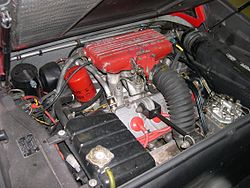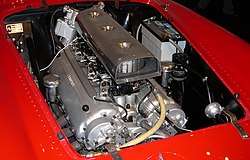This article needs additional citations for verification .(August 2020) |
This is a list of internal combustion engines manufactured by Ferrari.
This article needs additional citations for verification .(August 2020) |
This is a list of internal combustion engines manufactured by Ferrari.
Ferrari was rare among automobile manufacturers in attempting to build a straight-2 automobile engine. The racing prototype never made it to production. [1]
During the 90s Ferrari developed an experimental straight-3 two-stroke engine. [2] [3]

Lampredi designed a straight-4 engine for Formula Two use. Different versions of this engine were later used in Formula One and sports car racing.
Lampredi also modified his four into a straight-6 for racing use.
Ferrari's Dino project of the late 1956 gave birth to the company's well-known 65° V6 DOHC engines. This Vittorio Jano design formed the basis of the company's modern engines right up through the mid-2000s (decade). Another series of V6 engines was started in 1959 with a 60° V-angle and single overhead camshafts design.



The first Ferrari V8 engine was derived from a Lancia project, used in D50 F1 racecar. The Dino V8 family lasted from the early 1970s through 2004 when it was replaced by a new Ferrari/Maserati design.
Ferrari used V10 engines only for F1 racecars, between 1996 and 2005.





Ferrari is best known for its V12 engines.